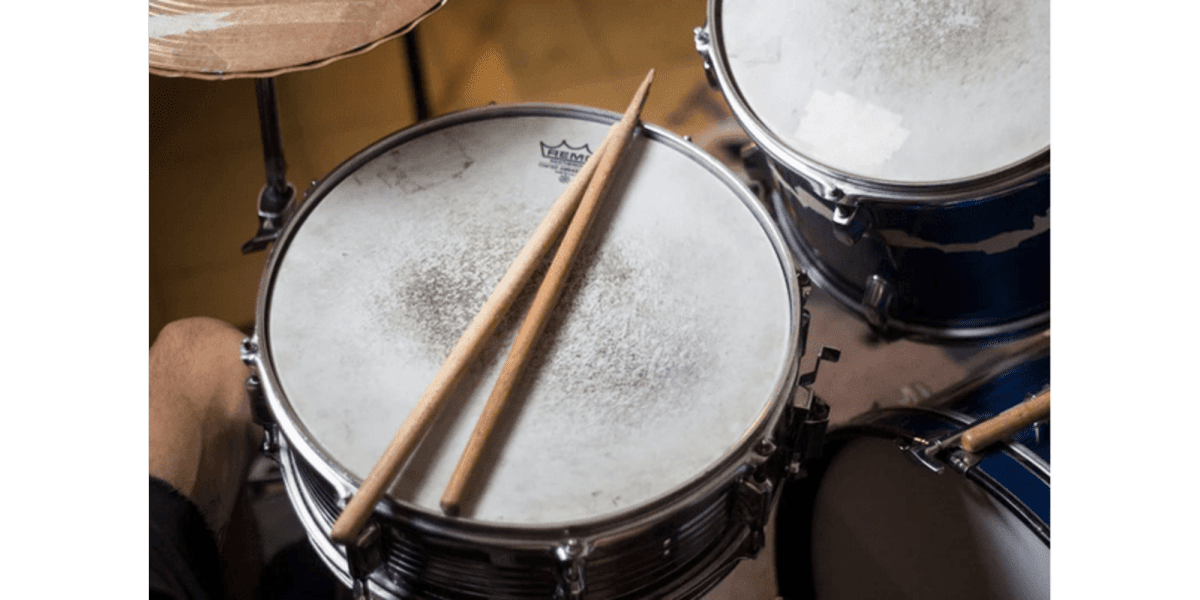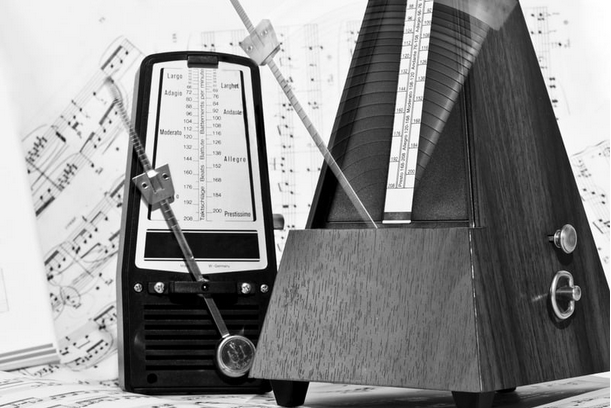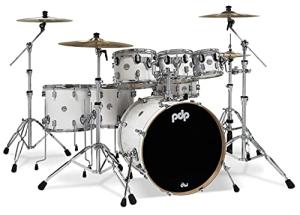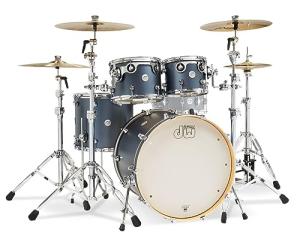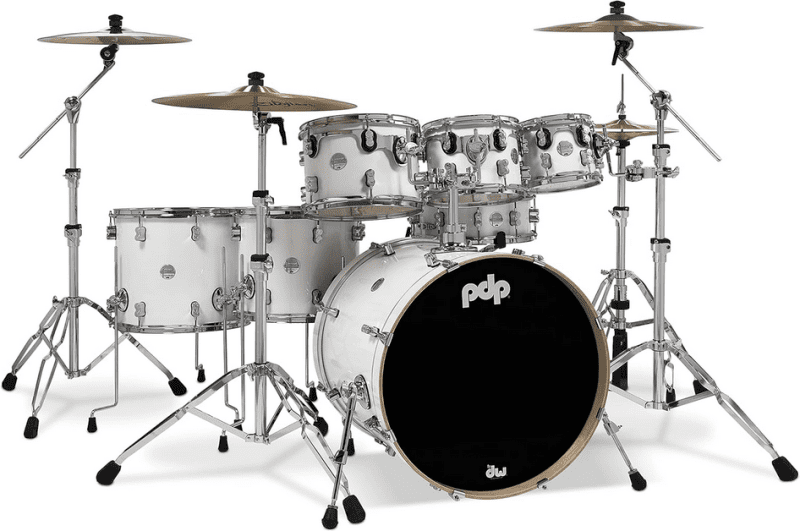Understanding Polyrhythms
Polyrhythms are an essential concept in drumming and music theory, allowing drummers to create complex rhythms by combining different time signatures and beats.
This section explores their definition, historical context, basic concepts of rhythm and time signatures, and the techniques for counting and notation.
Developing polyrhythms on the drums can seem like a daunting task at first, but it becomes much more manageable with the right approach.
Polyrhythms occur when two or more conflicting rhythms are played simultaneously, creating a unique and complex sound.
Understanding how to count and feel these rhythms is crucial for any drummer looking to improve their musical versatility.
To begin working on polyrhythms, start by practicing simple patterns such as a 3-over-4 polyrhythm, where three beats are played in the same time span as four.
This helps build a solid foundation and makes it easier to tackle more advanced patterns later on.
Many resources, like Peter Magadini’s "The Musician's Guide to Polyrhythms," are invaluable for learning methods and exercises that can improve your polyrhythmic skills.
As you gain confidence with basic polyrhythms, try incorporating them into your regular drum practice to see how they fit with different grooves and beats.
Advanced techniques may include playing different polyrhythms with each limb, adding a new level of complexity and musicality to your drumming.
Key Takeaways
- Basic polyrhythms such as 3-over-4 are essential starting points.
- Count and feel are crucial for mastering complex rhythms.
- Advanced techniques involve playing different polyrhythms with each limb.
Definition and Historical Context
Polyrhythms occur when two or more contrasting rhythms are played simultaneously. They are found in various musical genres, from jazz and disco to progressive rock.
Historically, polyrhythms have roots in African and Indian music. These traditions emphasize complex rhythmic patterns that set the foundation for many modern styles.
Western music adopted polyrhythms in the 20th century, enriching musical diversity.
Basic Concepts of Rhythm and Time Signatures
Understanding polyrhythms requires knowledge of basic rhythm and time signatures.
Time signatures indicate how many beats are in each measure and what note value equals one beat. For example, 4/4 time has four beats per measure, with each quarter note receiving one beat.
Polyrhythms often involve playing different time signatures simultaneously, such as a 3-over-4 rhythm where three beats are played over four beats.
This creates a layered rhythmic texture that appears complex but resolves after a set number of measures.
Counting and Notation
Counting polyrhythms involves breaking down each rhythm into its fundamental beats and counting them separately.
For instance, in a 3-over-4 polyrhythm, one drummer counts "1-2-3" while the other counts "1-2-3-4." This method helps musicians stay in sync.
Notation for polyrhythms uses special symbols and markings to show how different rhythms align within the same measure.
Drummers may use a table or grid layout to visualize how the beats intersect.
Understanding these techniques requires practice, but they are key to playing polyrhythms accurately.
Online resources, such as Total Drummer and SimplyDrum, offer lessons and exercises to help develop these skills.
Getting Started with Polyrhythms
When starting with polyrhythms, it’s essential to focus on basic exercises that establish a solid foundation. Developing independence between limbs will also aid in mastering complex rhythms.
Using metronomes and software can help maintain accuracy and consistent practice.
Basic Exercises
Begin with simple polyrhythms, such as 3:2 or 4:3.
For example, play triplets on a snare while maintaining quarter notes on a hi-hat. This helps train the brain to differentiate between two rhythms.
Use a practice pad if a drum kit isn't available. Set clear goals for each session and gradually increase the complexity.
Repeating these exercises helps in building muscle memory. Consistent practicing will slowly make these rhythms feel more natural.
Developing Independence
One key aspect of mastering polyrhythms is developing limb independence.
Begin with exercises that separate the hands and feet. For instance, practice playing 16th notes on the snare while keeping steady eighth notes on the bass drum.
Try combinations like right hand triplets and left-hand quarter notes.
Gradually introduce the hi-hat and other parts of the drum set. This way, each limb learns to work independently.
This technique takes time to master, but it's crucial for complex rhythms.
Using Metronomes and Software
Using a metronome is essential for maintaining consistent timing.
Set the metronome to a slow tempo and practice basic polyrhythms. Gradually increase the tempo as you become more comfortable.
This helps develop a strong sense of timing and precision.
Software and drum machines can also be useful tools.
Programs like Ableton or free online metronomes can provide varied click tracks. They can simulate different polyrhythms, making them easier to practice.
Practicing with these tools helps in internalizing complex rhythms and improving accuracy.
Advanced Polyrhythmic Techniques
Advanced polyrhythmic techniques allow drummers to master complex rhythms and enhance their musical creativity. These methods include combining different rhythmic structures, crafting intricate polyrhythmic grooves, and embracing experimentation for more complex rhythms.
Combining Different Rhythmic Structures
Combining various rhythmic structures is essential for developing advanced polyrhythmic techniques.
Drummers can start by using eighth note triplets alongside standard sixteenth notes. This creates a layered rhythm that sounds intricate and engaging.
Accents play a crucial role in making these combinations distinct.
Placing accents on different beats within the structure helps delineate each rhythm.
For instance, accentuating every third note in a pattern of four gives a feel of 3 over 4.
Cross rhythms, such as playing 3/4 on the hi-hat while maintaining a 4/4 beat on the bass drum, are another method.
This helps drummers practice independence and creates a rich, textured sound.
Combining these techniques allows for seamless blending of different rhythms, making the drum beat more dynamic and interesting.
Creating Polyrhythmic Grooves
Creating grooves with polyrhythms involves applying these complex rhythmic patterns into a cohesive musical context.
Start with a basic drum beat, then integrate a secondary rhythm on another drum or cymbal.
For example, initiate a basic 4/4 beat with the bass drum while layering triplets on the hi-hat. This forms the foundation of a polyrhythmic groove.
Adding accents on off-beats or syncopating certain notes can further enhance the groove.
Using different limb combinations, such as a rhythmic pattern on the snare drum while maintaining a steady bass drum pattern, adds depth.
Experimenting with ghost notes or drags on the snare can also add subtle complexities.
Layering different rhythms while maintaining the core beat is key to crafting compelling polyrhythmic grooves.
Experimentation and Complexity
Experimentation is crucial for mastering complex polyrhythmic techniques.
Drummers should explore various rhythmic patterns and time signatures to discover new sounds.
Practicing with a metronome at slower tempos helps in understanding the placement of each note within the polyrhythm.
Try playing 5/8 against a 4/4 beat or incorporating odd time signatures like 7/8.
This testing of various combinations fosters creativity and builds a unique drumming style.
Recording practice sessions can provide insights into areas of improvement.
Engaging in musical lessons or using guides like "The Musician’s Guide to Polyrhythms" by Peter Magadini offers structured learning paths.
These resources provide exercises that gradually increase in complexity. Experimentation combined with structured practice leads to mastery of complex rhythmic patterns.
Practical Application and Mastery
Mastering polyrhythms on the drum kit involves incorporating contrasting rhythms into various genres, establishing a solid practice routine, and utilizing drum fills and solos to enhance creativity. Below are some specifics to help musicians achieve these goals.
Incorporating Polyrhythms into Different Genres
Polyrhythms can enrich a wide range of music genres, from jazz to rock.
For instance, in jazz, drummers might layer a 3/2 rhythm over a standard swing beat to add complexity. In rock, 4/3 polyrhythms can create tension and excitement.
Understanding how different time signatures resolve over measures helps musicians apply polyrhythms effectively.
Examples:
- Jazz: Using triplets over straight eighths.
- Rock: Combining quarter notes with triplets.
Experimenting with these rhythms enhances the overall musical experience.
Practice Routines and Progress Tracking
Consistent practice routines are essential for mastering polyrhythms.
Start by isolating each rhythm before combining them. Use a metronome to keep steady time, beginning at a slower tempo and gradually increasing the speed.
Steps for Effective Practice:
- Practice each rhythm separately.
- Combine rhythms at a slow pace.
- Track progress using a practice journal.
Tracking your progress ensures improvement and helps identify areas needing more focus.
Drum Fills and Solos
Drum fills and solos allow drummers to showcase their mastery of polyrhythms and creativity.
Begin with simple fills incorporating basic polyrhythms and gradually develop more complex solos.
Tips for Drum Fills:
- Start with 2/3 fills.
- Integrate these fills into solos.
- Practice at various tempos.
Polyrhythms in fills and solos create dynamic and engaging performances, adding uniqueness to the drummer's style.
Resources for Further Learning
To effectively master polyrhythms on drums, various resources can be helpful. These resources include books and educational materials, online courses and tutorials, and opportunities for community and collaboration.
Books and Educational Materials
Books are a crucial way to learn the theory and practice of polyrhythms.
"Polyrhythms: The Musician's Guide" by Peter Magadini offers a comprehensive understanding of complex time signatures and practical exercises.
Tomás Howie's monthly lessons, such as those on Drumming Web, provide examples from influential albums like King Crimson's Thrak.
Such literature is rich in sheet music and exercises, giving drummers the tools to develop their skills.
Online Courses and Tutorials
Online courses offer structured learning experiences for drummers at all levels.
Sites like Total Drummer provide detailed lessons on playing polyrhythms on a drum kit.
Video tutorials, such as those available on Bang the Drum School, teach drummers how to hear and play different rhythms together.
These resources feature step-by-step instructions, printable exercises, and interactive content to facilitate learning.
Community and Collaboration
Joining a community of musicians can greatly enhance learning.
Participating in forums like those on Drum Forum allows drummers to share experiences and tips.
Collaborating with other musicians can provide real-time feedback and inspire creativity.
Engaging in local drum circles or attending workshops can also offer opportunities to practice polyrhythms in a supportive environment.
Frequently Asked Questions
Learning polyrhythms on the drum set can be challenging, but it is also very rewarding. Below are common questions that both beginners and advanced drummers may have about developing polyrhythmic skills.
What are the basic steps for a beginner to learn polyrhythms on the drum set?
Begin by practicing simple polyrhythms, such as 2:3, where two beats are played against three.
Start slowly and focus on maintaining a steady rhythm for both. Counting aloud can help keep track of each rhythm.
Where can I find online resources or courses for developing polyrhythms on drums?
Websites like Total Drummer and DrumForum offer online lessons and guides specifically for polyrhythm training.
Video tutorials can also be quite helpful.
What exercises can help in mastering polyrhythms on the drums?
Work on basic exercises in which each hand plays a different rhythm, such as quarter notes with one hand and eighth-note triplets with the other.
Gradually increase the complexity as you become more comfortable.
How does one maintain proper drum set orientation while playing complex polyrhythms?
Keep a relaxed posture and ensure you’re not tensing up while playing.
Proper technique helps you maintain orientation. Practice routines that slowly build up the complexity to ensure comfort at every step.
Which drum independence exercises are effective for improving polyrhythmic playing?
Independence exercises involve practicing each limb separately before combining them.
For instance, play a steady beat with one hand while incorporating different rhythms with the other hand and your feet.
How can I create my drum polyrhythms and apply them musically?
Start by experimenting with different rhythmic patterns and combining them. Use a metronome to keep time. Then, gradually build complexity.
Applying these patterns in musical contexts involves integrating them into your regular practice and improvisation sessions.
DISCLAIMER
The information contained on Percussion Pros website and our related pages is provided for entertainment and informational purposes only. It is not intended as a substitute for the advice of or treatment that your physician or other health care provider may prescribe.
Understand that you are solely responsible for the way this information is perceived and utilized, and do so at your own risk. In no way will Percussion Pros be responsible for injuries or other problems that might occur due to the use of this website or any actions taken based on the content of this website. Save on Sneaks will not be held responsible for the conduct of any companies and websites recommended within this site.
